tow TOYOTA HIGHLANDER HYBRID 2022 Owners Manual
[x] Cancel search | Manufacturer: TOYOTA, Model Year: 2022, Model line: HIGHLANDER HYBRID, Model: TOYOTA HIGHLANDER HYBRID 2022Pages: 572, PDF Size: 14.5 MB
Page 2 of 572
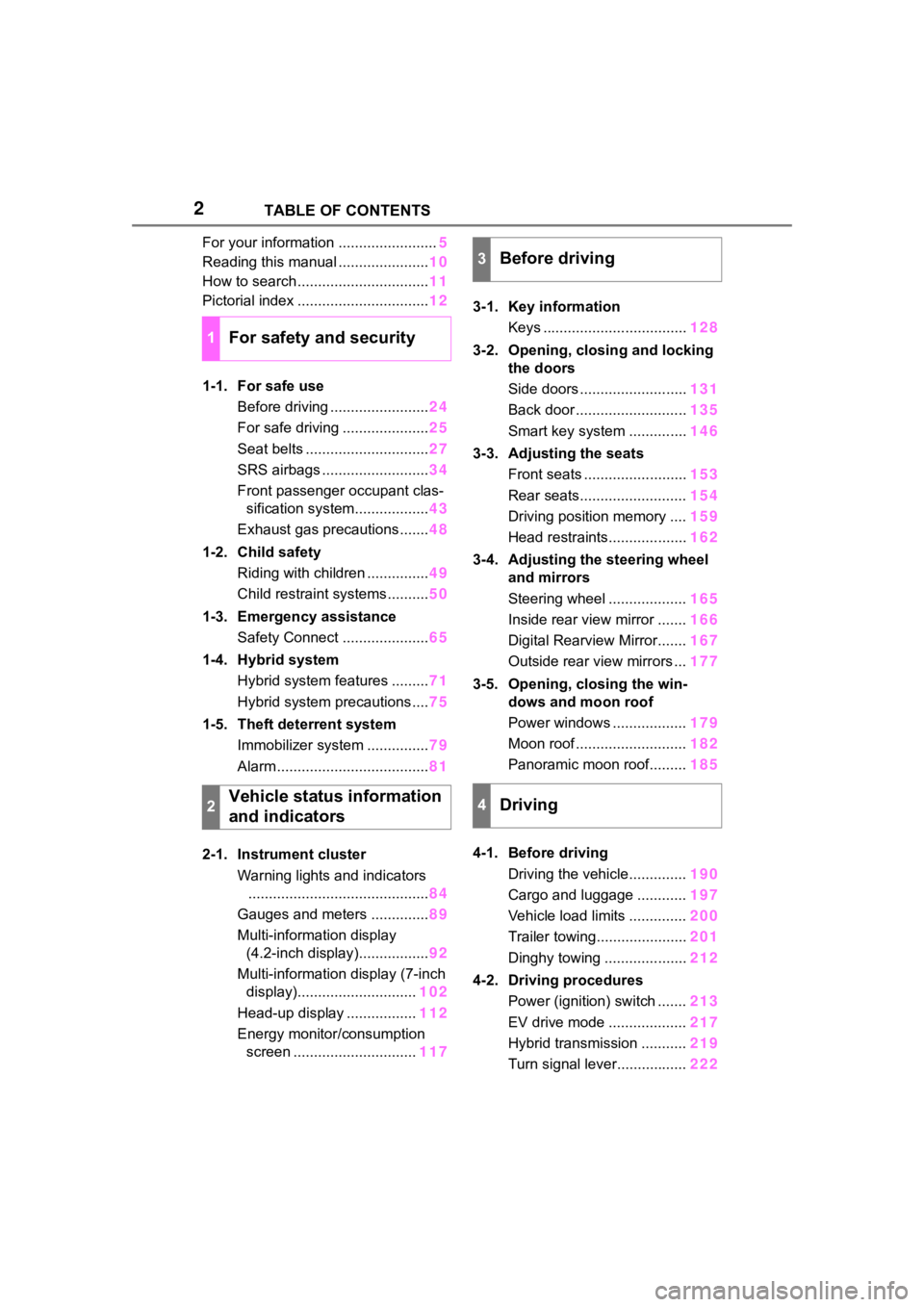
2TABLE OF CONTENTS
For your information ........................5
Reading this manual ...................... 10
How to search ................................ 11
Pictorial index ................................ 12
1-1. For safe use Before driving ........................ 24
For safe driving ..................... 25
Seat belts .............................. 27
SRS airbags .......................... 34
Front passenger occupant clas- sification system.................. 43
Exhaust gas precautions....... 48
1-2. Child safety Riding with children ............... 49
Child restraint systems .......... 50
1-3. Emergency assistance Safety Connect ..................... 65
1-4. Hybrid system Hybrid system features ......... 71
Hybrid system precautions .... 75
1-5. Theft deterrent system Immobilizer system ............... 79
Alarm ..................................... 81
2-1. Instrument cluster Warning lights and indicators............................................ 84
Gauges and meters .............. 89
Multi-information display (4.2-inch display)................. 92
Multi-information display (7-inch display)............................. 102
Head-up display ................. 112
Energy monitor/consumption screen .............................. 1173-1. Key information
Keys ................................... 128
3-2. Opening, closing and locking the doors
Side doors .......................... 131
Back door ........................... 135
Smart key system .............. 146
3-3. Adjusting the seats Front seats ......................... 153
Rear seats.......................... 154
Driving position memory .... 159
Head restraints................... 162
3-4. Adjusting the steering wheel and mirrors
Steering wheel ................... 165
Inside rear view mirror ....... 166
Digital Rearview Mirror....... 167
Outside rear view mirrors ... 177
3-5. Opening, closing the win- dows and moon roof
Power windows .................. 179
Moon roof ........................... 182
Panoramic moon roof......... 185
4-1. Before driving Driving the vehicle.............. 190
Cargo and luggage ............ 197
Vehicle load limits .............. 200
T ra
iler towing...................... 201
Dinghy towing .................... 212
4-2. Driving procedures Power (ignition) switch ....... 213
EV drive mode ................... 217
Hybrid transmission ........... 219
Turn signal lever................. 222
1For safety and security
2Vehicle status information
and indicators
3Before driving
4Driving
Page 4 of 572
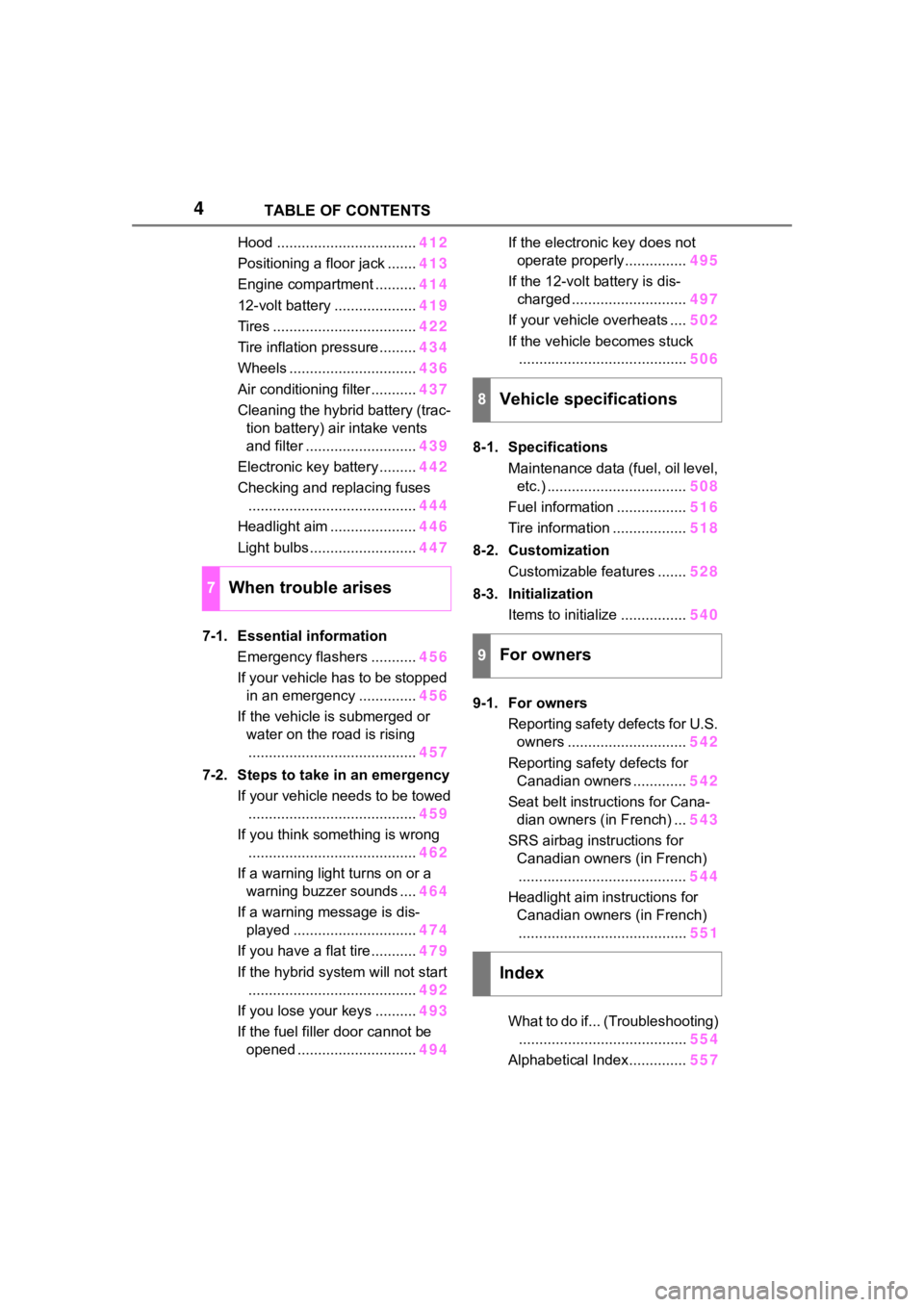
4TABLE OF CONTENTS
Hood ..................................412
Positioning a floor jack ....... 413
Engine compartment .......... 414
12-volt battery .................... 419
Tires ................................... 422
Tire inflation pressure......... 434
Wheels ............................... 436
Air conditioning filter ........... 437
Cleaning the hybrid battery (trac- tion battery) air intake vents
and filter ........................... 439
Electronic key battery ......... 442
Checking and replacing fuses ......................................... 444
Headlight aim ..................... 446
Light bulbs .......................... 447
7-1. Essential information Emergency flashers ........... 456
If your vehicle has to be stopped in an emergency .............. 456
If the vehicle is submerged or water on the road is rising
......................................... 457
7-2. Steps to take in an emergency If your vehicle needs to be towed......................................... 459
If you think something is wrong ......................................... 462
If a warning light turns on or a warning buzzer sounds .... 464
If a warning message is dis- played .............................. 474
If you have a flat tire ........... 479
If the hybrid system will not start ......................................... 492
If you lose your keys .......... 493
If the fuel filler door cannot be opened ............................. 494If the electronic key does not
operate properly............... 495
If the 12-volt battery is dis- charged ............................ 497
If your vehicle overheats .... 502
If the vehicle becomes stuck ......................................... 506
8-1. Specifications Maintenance data (fuel, oil level, etc.) .................................. 508
Fuel information ................. 516
Tire information .................. 518
8-2. Customization Customizable features ....... 528
8-3. Initialization Items to initialize ................ 540
9-1. For owners Reporting safety defects for U.S. owners ............................. 542
Reporting safety defects for Canadian owners ............. 542
Seat belt instructions for Cana- dian owners (in French) ... 543
SRS airbag instructions for Canadian owners (in French)......................................... 544
Headlight aim instructions for Canadian owners (in French)
........ ................................. 551
What
to do if... (Troubleshooting)
......................................... 554
Alphabetical Index.............. 557
7When trouble arises
8Vehicle specifications
9For owners
Index
Page 15 of 572
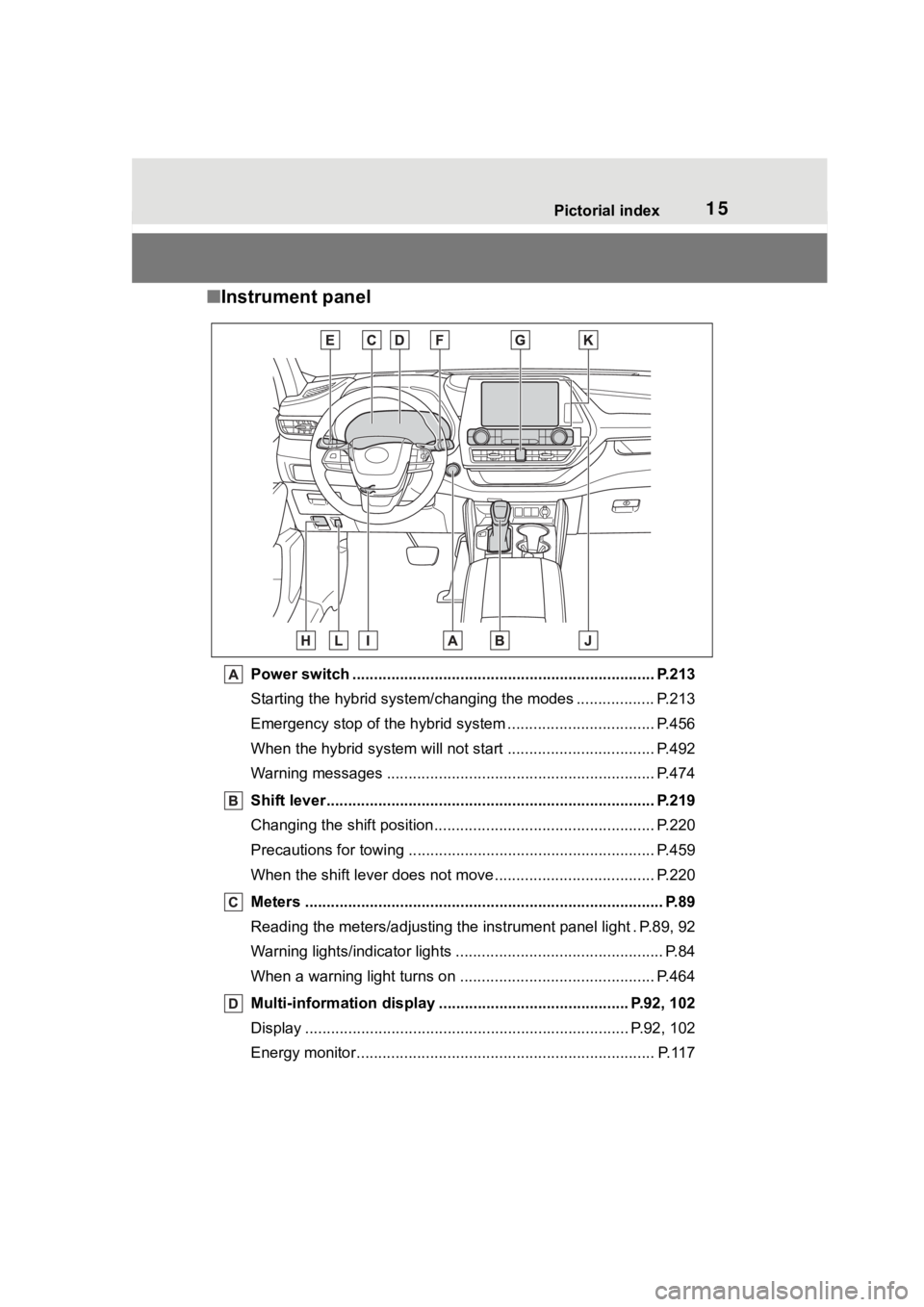
15Pictorial index
■Instrument panel
Power switch ................................................... ................... P.213
Starting the hybrid system/changing the modes .................. P. 2 1 3
Emergency stop of the hybrid system ............................ ...... P.456
When the hybrid system will not start .......................... ........ P.492
Warning messages ............................................... ............... P.474
Shift lever.................................................... ........................ P.219
Changing the shift position.................................... ............... P.220
Precautions for towing .. ....................................... ................ P.459
When the shift lever does not move............................. ........ P.220
Meters ......................................................... .......................... P.89
Reading the meters/adjusting the instrument panel light . P.89, 9 2
Warning lights/indicator lights ................................ ................ P.84
When a warning light turns on .................................. ........... P.464
Multi-information display . ........................................... P.92, 102
Display ........................................................ ................... P.92, 102
Energy monitor................................................. .................... P.117
Page 31 of 572
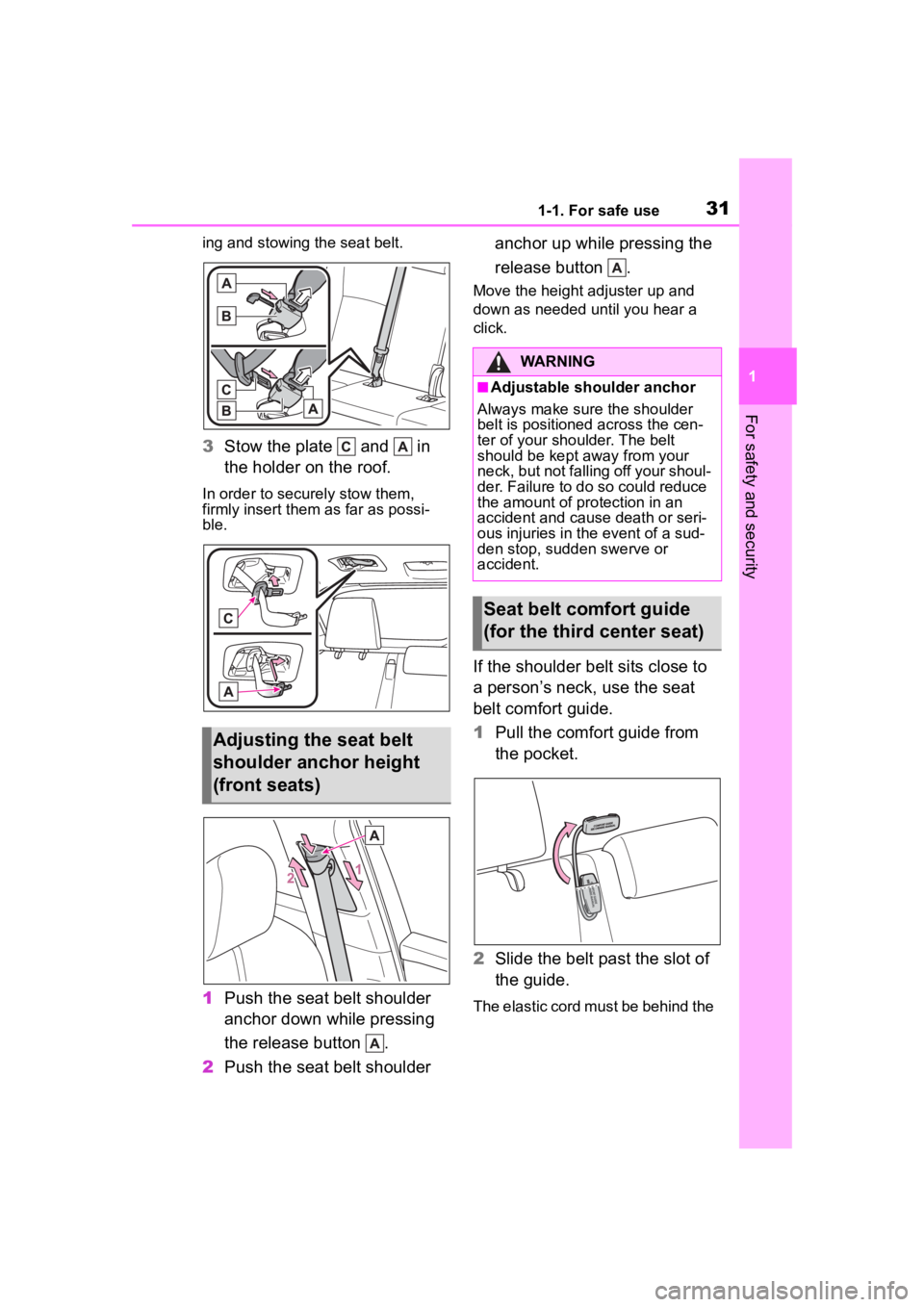
311-1. For safe use
1
For safety and security
ing and stowing the seat belt.
3Stow the plate and in
the holder on the roof.
In order to securely stow them,
firmly insert them as far as possi-
ble.
1Push the seat belt shoulder
anchor down while pressing
the release button .
2 Push the seat belt shoulder anchor up while pressing the
release button .
Move the height adjuster up and
down as needed until you hear a
click.
If the shoulder belt sits close to
a person’s neck, use the seat
belt comfort guide.
1
Pull the comfort guide from
the pocket.
2 Slide the belt past the slot of
the guide.
The elastic cord must be behind the
Adjusting the seat belt
shoulder anchor height
(front seats)
WARNING
■Adjustable shoulder anchor
Always make sure the shoulder
belt is positioned across the cen-
ter of your shoulder. The belt
should be kept away from your
neck, but not falling off your shoul-
der. Failure to do so could reduce
the amount of protection in an
accident and cause death or seri-
ous injuries in the event of a sud-
den stop, sudden swerve or
accident.
Seat belt comfort guide
(for the third center seat)
Page 40 of 572
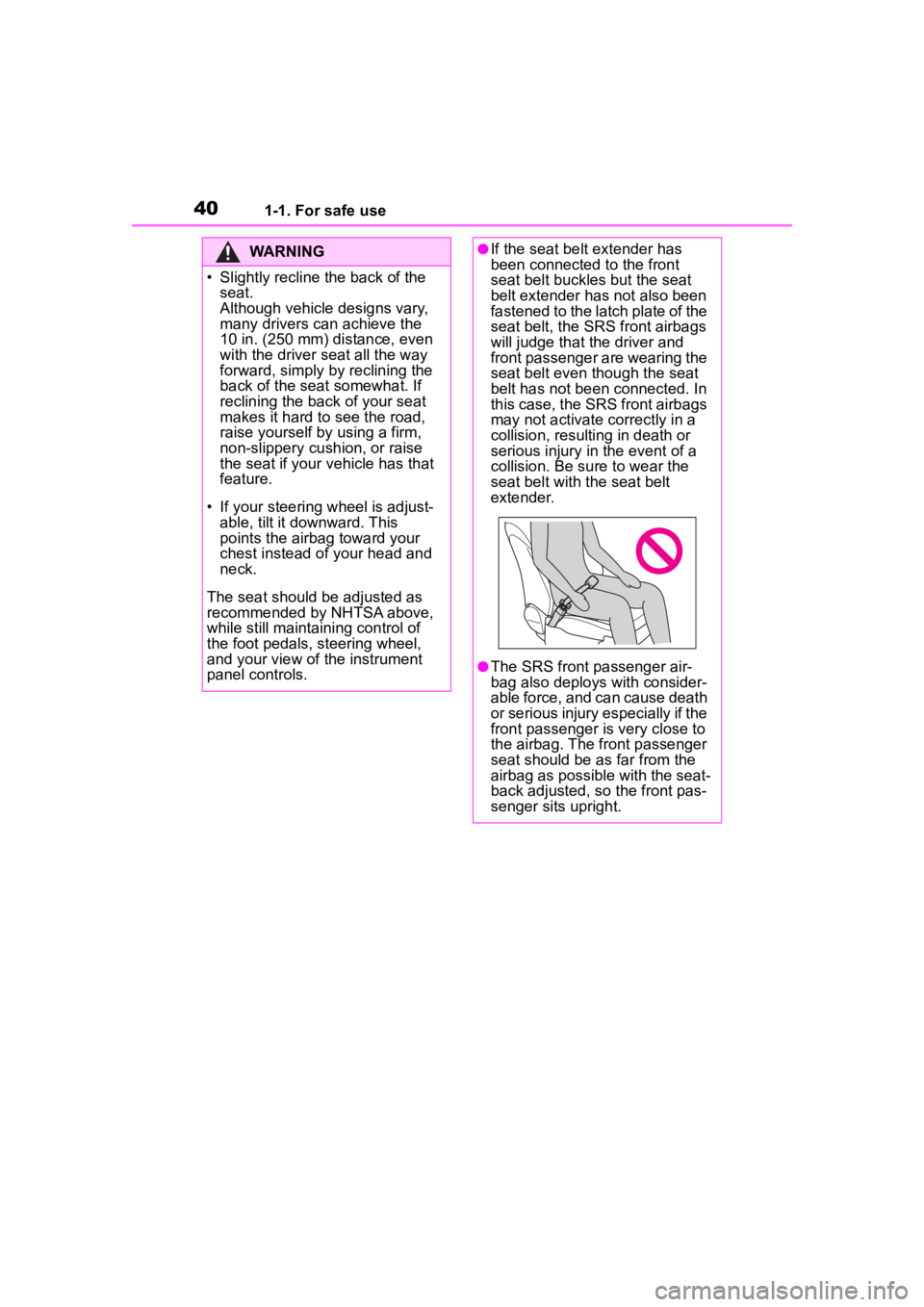
401-1. For safe use
WARNING
• Slightly recline the back of the seat.
Although vehicle designs vary,
many drivers can achieve the
10 in. (250 mm) distance, even
with the driver seat all the way
forward, simply by reclining the
back of the seat somewhat. If
reclining the back of your seat
makes it hard to see the road,
raise yourself by using a firm,
non-slippery cushion, or raise
the seat if your vehicle has that
feature.
• If your steering wheel is adjust- able, tilt it downward. This
points the airbag toward your
chest instead of your head and
neck.
The seat should be adjusted as
recommended by NHTSA above,
while still maintaining control of
the foot pedals, steering wheel,
and your view of the instrument
panel controls.
●If the seat belt extender has
been connected to the front
seat belt buckles but the seat
belt extender has not also been
fastened to the latch plate of the
seat belt, the SRS front airbags
will judge that the driver and
front passenger are wearing the
seat belt even though the seat
belt has not been connected. In
this case, the SRS front airbags
may not activate correctly in a
collision, resulting in death or
serious injury in the event of a
collision. Be su re to wear the
seat belt with the seat belt
extender.
●The SRS front passenger air-
bag also deploys with consider-
able force, and can cause death
or serious injury especially if the
front passenger is very close to
the airbag. The front passenger
seat should be as far from the
airbag as possible with the seat-
back adjusted, so the front pas-
senger sits upright.
Page 41 of 572
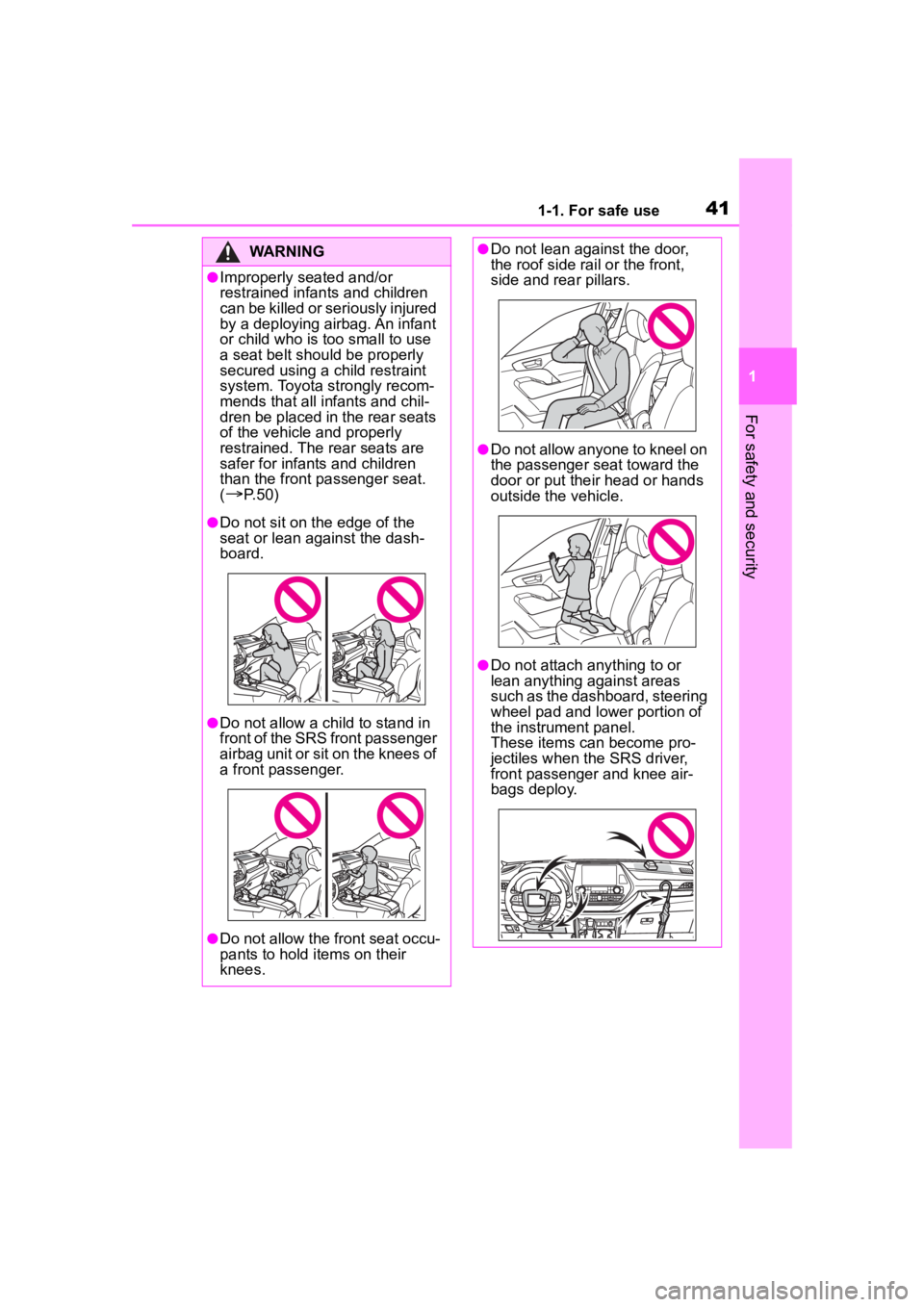
411-1. For safe use
1
For safety and security
WARNING
●Improperly seated and/or
restrained infants and children
can be killed or seriously injured
by a deploying airbag. An infant
or child who is too small to use
a seat belt should be properly
secured using a child restraint
system. Toyota strongly recom-
mends that all infants and chil-
dren be placed in the rear seats
of the vehicle and properly
restrained. The rear seats are
safer for infants and children
than the front passenger seat.
(
P. 5 0 )
●Do not sit on the edge of the
seat or lean against the dash-
board.
●Do not allow a child to stand in
front of the SRS front passenger
airbag unit or sit on the knees of
a front passenger.
●Do not allow the front seat occu-
pants to hold items on their
knees.
●Do not lean against the door,
the roof side rail or the front,
side and rear pillars.
●Do not allow anyone to kneel on
the passenger seat toward the
door or put their head or hands
outside the vehicle.
●Do not attach anything to or
lean anything against areas
such as the dashboard, steering
wheel pad and lower portion of
the instrument panel.
These items can become pro-
jectiles when th e SRS driver,
front passenger and knee air-
bags deploy.
Page 59 of 572
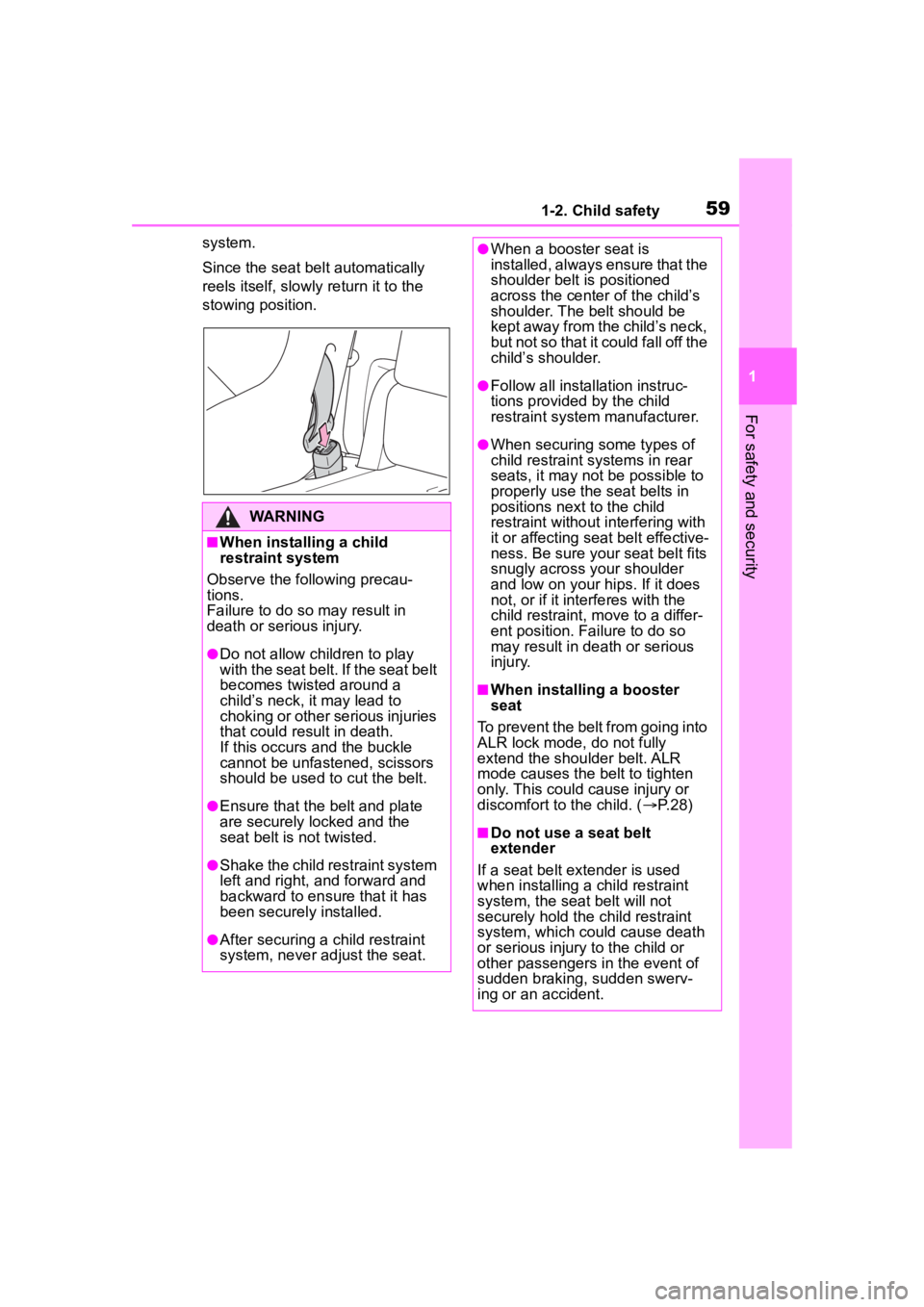
591-2. Child safety
1
For safety and security
system.
Since the seat belt automatically
reels itself, slowly return it to the
stowing position.
WARNING
■When installing a child
restraint system
Observe the following precau-
tions.
Failure to do so m ay result in
death or serious injury.
●Do not allow children to play
with the seat belt. If the seat belt
becomes twisted around a
child’s neck, it may lead to
choking or other serious injuries
that could result in death.
If this occurs and the buckle
cannot be unfastened, scissors
should be used to cut the belt.
●Ensure that the belt and plate
are securely locked and the
seat belt is not twisted.
●Shake the child restraint system
left and right, and forward and
backward to ensure that it has
been securely installed.
●After securing a child restraint
system, never adjust the seat.
●When a booster seat is
installed, always ensure that the
shoulder belt is positioned
across the center of the child’s
shoulder. The belt should be
kept away from the child’s neck,
but not so that it could fall off the
child’s shoulder.
●Follow all installation instruc-
tions provided by the child
restraint system manufacturer.
●When securing some types of
child restraint systems in rear
seats, it may not be possible to
properly use the seat belts in
positions next to the child
restraint without interfering with
it or affecting seat belt effective-
ness. Be sure your seat belt fits
snugly across your shoulder
and low on your hips. If it does
not, or if it interferes with the
child restraint, move to a differ-
ent position. Fa ilure to do so
may result in death or serious
injury.
■When installing a booster
seat
To prevent the belt from going into
ALR lock mode, do not fully
extend the shoulder belt. ALR
mode causes the belt to tighten
only. This could cause injury or
discomfort to the child. ( P. 2 8 )
■Do not use a seat belt
extender
If a seat belt extender is used
when installing a child restraint
system, the seat belt will not
securely hold the child restraint
system, which could cause death
or serious injury to the child or
other passengers in the event of
sudden braking, sudden swerv-
ing or an accident.
Page 69 of 572

691-3. Emergency assistance
1
For safety and security
■Emergency Assistance But-
ton (“SOS”)
In the event of an emergency on
the road, push the “SOS” button
to reach the Safety Connect
response center. The answer-
ing agent will determine your
vehicle’s location, assess the
emergency, and dispatch the
necessary assistance required.
If you accidentally press the “SOS”
button, tell the response-center
agent that you are not experiencing
an emergency.
■Enhanced Roadside Assis-
tance
Enhanced Roadside Assistance
adds GPS data to the already
included warranty-based Toyota
roadside service.
Subscribers can press the
“SOS” button to reach a Safety
Connect response-center agent,
who can help with a wide range
of needs, such as: towing, flat
tire, fuel delivery, etc. For a
description of the Enhanced
Roadside Assistance services
and their limitations, please see
the Safety Connect Terms and
Conditions, which are available
at Toyota.com in the United
States, Toyotapr.com in Puerto
Rico and Toyota.ca in Canada.
Important! Read this informa- tion before using Safety Con-
nect.
■Exposure to radio fre-
quency signals
The Safety Connect system
installed in your vehicle is a
low-power radio transmitter and
receiver. It receives and also
sends out radio frequency (RF)
signals.
In August 1996, the Federal
Communications Commission
(FCC) adopted RF exposure
guidelines with safety levels for
mobile wireless phones. Those
guidelines are consistent with
the safety standards previously
set by the following U.S. and
international standards bodies.
ANSI (American National
Standards Institute) C95.1
[1992]
NCRP (National Council on
Radiation Protection and
Measurement) Report 86
[1986]
ICNIRP (International Com-
mission on Non-Ionizing Radi-
ation Protection) [1996]
Those standards were based on
comprehensive and periodic
evaluations of the relevant sci-
entific literature. Over 120 scien-
tists, engineers, and physicians
from universities, and govern-
ment health agencies and
industries reviewed the avail-
able body of research to
Safety information for
Safety Connect
Page 77 of 572

771-4. Hybrid system
1
For safety and security
There are air intake vents under
each side of the second seat for
the purpose of cooling the
hybrid battery (traction battery).
If the vent is blocked,
charging/discharging of the
hybrid battery (traction battery)
may become limited.
WARNING
●If your vehicle needs to be
towed, do so with all four
wheels raised. If the wheels
connected to the electric motor
(traction motor) are on the
ground when towing, the motor
may continue to generate elec-
tricity. This may cause a fire.
( P.459)
●Carefully inspect the ground
under the vehicle. If you find
that liquid has leaked onto the
ground, the fuel system may
have been damaged. Leave the
vehicle as soon as possible.
■Hybrid battery (traction bat-
tery)
●Never resell, hand over or mod-
ify the hybrid battery. To prevent
accidents, hybrid batteries that
have been removed from a dis-
posed vehicle are collected
through your Toyota dealer. Do
not dispose of the battery your-
self.
Unless the battery is properly col-
lected, the following may occur,
resulting in dea th or serious
injury:
• The hybrid battery may be ille- gally disposed of or dumped,
and it is hazardous to the envi-
ronment or someone may touch
a high voltage part, resulting in
an electric shock.
• The hybrid battery is intended to be used exclusively with your
hybrid vehicle. If the hybrid bat-
tery is used outside of your
vehicle or modified in any way,
accidents such as electric
shock, heat generation, smoke
generation, an explosion and
electrolyte leakage may occur.
When reselling or handing over
your vehicle, the possibility of an
accident is extremely high
because the person receiving the
vehicle may not be aware of these
dangers.
●If your vehicle is disposed of
without the hybrid battery hav-
ing been removed, there is a
danger of serious electric shock
if high voltage parts, cables and
their connectors are touched. In
the event that your vehicle must
be disposed of, the hybrid bat-
tery must be disposed of by
your Toyota dealer or a qualified
service shop. If the hybrid bat-
tery is not disposed of properly,
it may cause electric shock that
can result in dea th or serious
injury.
NOTICE
■Hybrid battery (traction bat-
tery) air intake vents
Do not carry large amounts of
water such as water cooler bottles
in the vehicle. If water spills onto
the hybrid battery (traction bat-
tery), the battery may be dam-
aged. Have the vehicle inspected
by your Toyota dealer.
Hybrid battery (traction
battery) air intake vent
Page 138 of 572
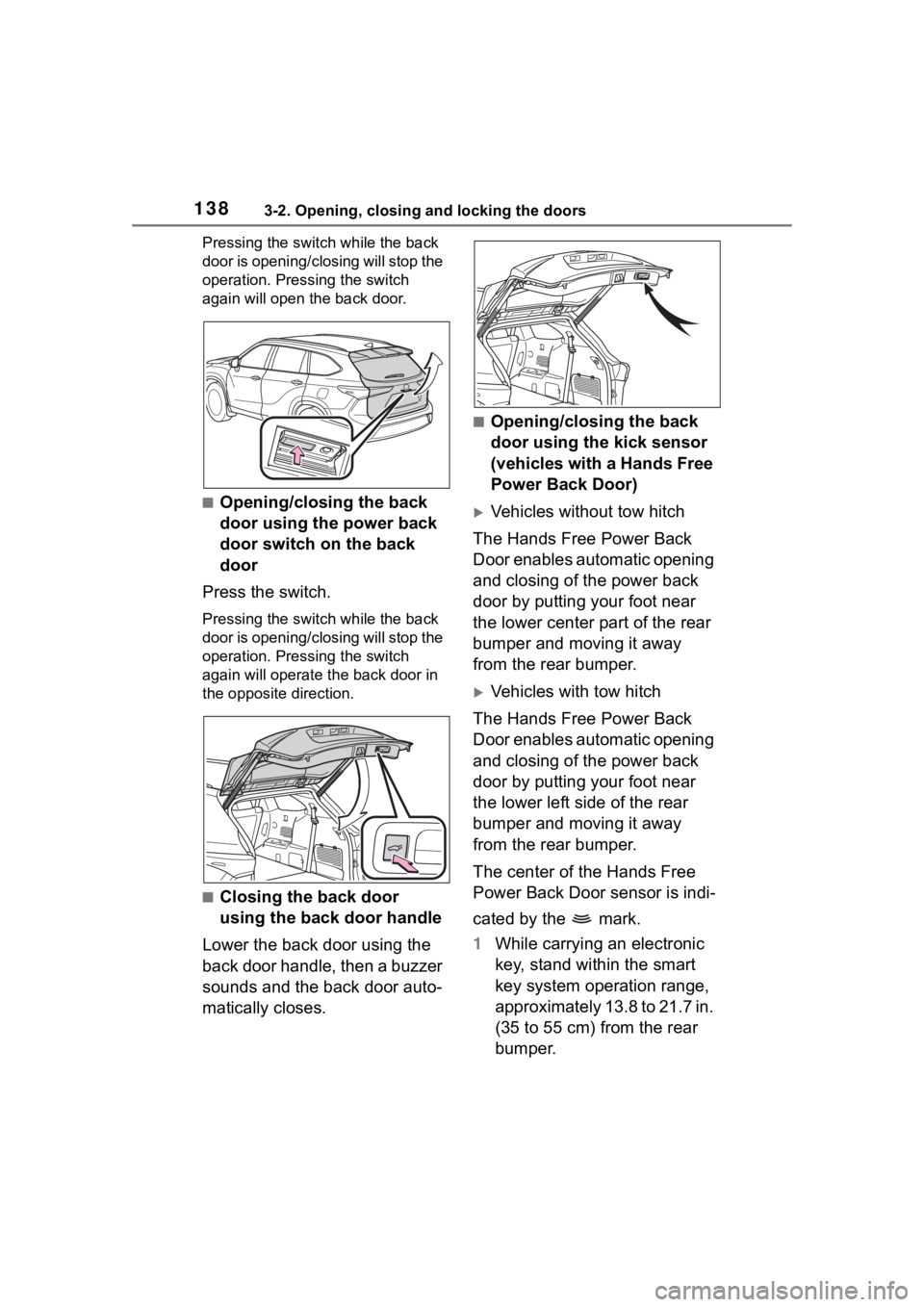
1383-2. Opening, closing and locking the doors
Pressing the switch while the back
door is opening/closing will stop the
operation. Pressing the switch
again will open the back door.
■Opening/closing the back
door using the power back
door switch on the back
door
Press the switch.
Pressing the switch while the back
door is opening/closing will stop the
operation. Pressing the switch
again will operate th e back door in
the opposite direction.
■Closing the back door
using the back door handle
Lower the back door using the
back door handle, then a buzzer
sounds and the back door auto-
matically closes.
■Opening/closing the back
door using the kick sensor
(vehicles with a Hands Free
Power Back Door)
Vehicles without tow hitch
The Hands Free Power Back
Door enables automatic opening
and closing of the power back
door by putting your foot near
the lower center part of the rear
bumper and moving it away
from the rear bumper.
Vehicles with tow hitch
The Hands Free Power Back
Door enables automatic opening
and closing of the power back
door by putting your foot near
the lower left side of the rear
bumper and moving it away
from the rear bumper.
The center of the Hands Free
Power Back Door sensor is indi-
cated by the mark.
1 While carrying an electronic
key, stand within the smart
key system operation range,
approximately 13.8 to 21.7 in.
(35 to 55 cm) from the rear
bumper.